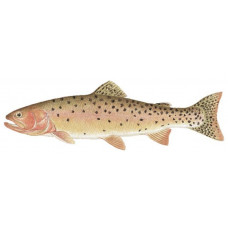Latin name
Oncorhynchus clarki
Other names
Сut, native trout, coastal cutthroat, Clark’s trout, red-throated trout, shorttailed trout, lake trout, sea trout, brook trout, native trout, Yellowstone cutthroat, Snake River cutthroat, Lahontan cutthroat, Rio Grande cutthroat, Colorado cutthroat, Utah cutthroat, Paiute cutthroat, harvest trout, blackspotted trout; French: truite fardée.
Identification
It is a very variable fish, both in coloration and size. The characteristic feature that gave the cutthroat its name is a yellow, orange, or red stripe or slit in the skin fold on each side below the lower jaw. Body color varies from cadmium blue and silvery to olive green or yellowish green. There may be red patches on the sides of the head, front of the body, and belly. Some specimens may have a narrow pink stripe along the sides, but not as wide as a rainbow trout. The body is covered with black spots that extend to the dorsal, adipose, and caudal fins. On the tail, which is slightly forked, the spots are evenly distributed outward. Cutthroat coloration also depends on habitat and life history. Fish living in swampy ponds are usually 6 to 16 inches long, golden yellow with dark spots on the body, dorsal and caudal fins, and a bright red stripe under the jaw. Free-swimming residents of large landlocked lakes can exceed 24 inches in length and have a uniform silver coloration with black spots, a pink gill cover, and a faint diagonal stripe. The sea-run cutthroat rarely exceeds 18 inches in length and is bluish-silver with a dark or olive back and less prominent black spots, the characteristic stripe being dull yellow.
Distribution
Cutthroat trout are the most widely distributed of all western trout in North America, as evidenced by the many names that refer to rivers, states, or waterways where unique forms are found. Coastal cutthroat trout are typically found no more than 100 miles from the coast. It is known from the Eel River, California, north to Prince William Sound, Alaska. Inland non-anadromous forms occur from southern Alberta, Canada, to southern New Mexico, east to Colorado and much of Montana, and west to Alberta and eastern California. A small, dispersed, possibly transplanted population inhabits the northern part of Baja California, Mexico. This species has been transplanted to other locations, including the east coast of Quebec, Canada, and Europe.
Habitat
Inland and resident (non-anadromous) coastal cutthroat inhabit a wide variety of coldwater habitats, from small headwater tributaries, mountain streams, and swamp ponds to large lakes and rivers. During spawning migrations, sea-run cutthroat usually inhabit river or stream systems with accessible lakes, otherwise they remain in saltwater near shore and in native tributaries. In some watersheds, anadromous and resident sea-run cutthroat coexist.
Size
The largest form (or subspecies) of O. clarki was once the Lahontan cutthroat, found in the Lahontan drainage of Nevada and California, but is now nearly extinct. The smallest cutthroat is found only in the headwaters of Silver King Creek, California, and does not exceed 12 inches. Coastal anadromous cutthroats reach 17 pounds, but average no more than 5 pounds, while most inland specimens rarely exceed 5 pounds. Most cutthroats live from 4 to 7 years, with a maximum life span of at least 12 years.
Life history and Behavior
Cutthroat trout spawn in late winter or early spring, although the saltwater fish typically ascend streams in late summer or fall of the year prior to spawning. They spawn in small, isolated headwater streams. The female makes one or more nests. The eggs hatch after 6-7 weeks. Juveniles later colonize beaver ponds, wetlands, or lakes. In lakes, small brook trout and non-anadromous shore trout hide among lilies, sunken logs, or trash, from which they emerge to feed on insects and small fish. Some fish abandon this "sit and wait" feeding strategy when they reach about 14 inches and become cruisers, chasing and eating other fish. Cutthroat trout that adopt this feeding strategy can grow from 24 to 28 inches and weigh 8 pounds.
Food and feeding habits
Inland cutthroats, which live in inland waters, feed primarily on insects and small fish. Coastal cutthroats eat a variety of small fish, shrimp, sand, and squid.
Reproduction
No information
| Classification | |
| Phylum | Chordata |
| Class | Actinopterygii |
| Squad | Salmoniformes |
| Family | Salmonidae |
| Genus | Oncorhynchus |
| Species | O. clarkii |
| Features | |
| Conservation status | No information |
| Habitat | Littoral |
| Life span, years | 12 |
| Maximum body weight, kg | 19 |
| Maximum length, cm | 99 |
| Sailing speed, m/s | No information |
| Threat to people | Edible |
| Way of eating | Predator |


